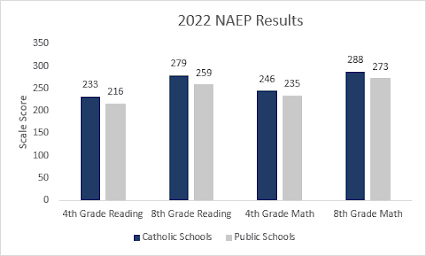Catholic Schools Shine on Nation's Report Card
Last month, NCES released a report on the NAEP long-term trend (LTT) reading and mathematics assessments for age 9 students through 2022 to examine student achievement during the COVID-19 pandemic. It summarized alarming declines over the last two years that saw the largest score drops in decades for reading and the first ever for math.
In math, Catholic school students nationally saw no changes to their pre-pandemic NAEP scale scores for 4th grade, and a statistically significant decline of 5 points in 8th grade, which was smaller than the declines by public (-8) and charter (-9) schools. In reading, Catholic schools scores actually increased by 1 point in 8th grade and decreased by 2 points in 4th grade, neither of which was statistically significant, but both of which outpaced public and charter schools, which both declined 3 points at each level.
The main NAEP also samples some of the nation’s largest urban public districts, including Cleveland, which allows for some interesting observations. The NAEP scores revealed sharp declines, even steeper than those reported on Ohio’s State Report Card. Though NAEP does not break out Catholic schools by district, the Diocese of Cleveland’s NWEA MAP proficiency results, a separate but similarly derived performance standard, showed similar trends to the nation for Catholic schools in the City of Cleveland.
Catholic schools in the city either increased or declined the least from before the pandemic through the 2021-2022 school year in math and reading at grades 4 and 8. Proficiency levels in Cleveland Catholic school math and reading remained level, anywhere from several percentage points stronger than their counterparts on the state report cards, to as much as 3 times and 4 times the proficiency projected by NAEP for grades 8 and 4, respectively.
Catholic elementary schools are largely neighborhood schools, demographically similar to the communities they serve. In the City of Cleveland, elementary students are 75% low income (qualifying for the federal free or reduced-priced lunch program), 4% Limited English Proficiency. Their racial makeup is 43% Black, 29% White, 16% Latino, and 9% Multiracial, and 8% of students have diagnosed special needs. About two thirds of students in the city are not Catholic, and nearly all attend on a state scholarship.
The Diocese’s total enrollment of more than 35,000 K-12 students makes it the third largest of any system in Ohio, which as a state saw overall declines in proficiency in reading and math at both grade levels. The diocese’s overall Catholic school enrollment actually grew 1.2% in the 2021-22 school year, and so did the percentage of students achieving proficiency in 8th grade math (+4%) and reading (+3%) as well as 4th grade math (+6%) with slight decline in reading (-1%).
Catholic schools believe that every person is a gift from God, and our educators lived that belief by doing all they could to serve students as well as possible during arguably the most challenging educational conditions in our lifetimes. Clearly there is much more work to be done, as the challenges of the pandemic years affected everyone. But the heroic efforts of our educators to meet the needs of all children mean that we can focus less on recovering from loss and more on continuing to grow both in academic performance as well as in the values and virtues that are the bedrock of a Catholic school education.
Our colleague Kathleen Porter-Magee, superintendent of the Partnership Schools network, including four urban diocesan schools in Cleveland and seven in the Archdiocese of New York called the NAEP results “a reflection of the hard work that Catholic school teachers and leaders have been doing throughout the pandemic and…a reflection of what Catholic schools’ mission-driven, faith-filled and community-focused leadership has done to support kids and communities throughout Covid.”
The success of our Catholic schools over the last two years demonstrates all that and more, including the value of providing parents with widely available school choice -- something we have in the city of Cleveland that the much of the rest of the state and much of the nation still lack. While the NWEA and NAEP proficiency levels are were not designed for direct comparison, it is the consistent trends here that are the story. Catholic schools are animated by a transcendent mission well beyond academic report cards, to educate young people in the faith and form them for lifetimes of flourishing. As schools of choice, Catholic schools are directly accountable to parents. These are two features that every family should have available to them in a school. In fact, it is a position long held by the Catholic Church that all parents who wish to form young people in faith and virtues, should have public support to choose the education best suited for their children.





